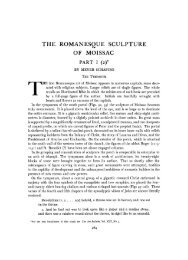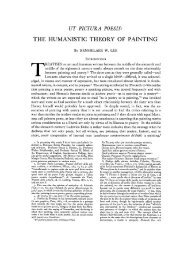Tragic Pompeii - College Art Association
Tragic Pompeii - College Art Association
Tragic Pompeii - College Art Association
Create successful ePaper yourself
Turn your PDF publications into a flip-book with our unique Google optimized e-Paper software.
232 THE ART BULLETIN JUNE 1994 VOLUME LXXVI NUMBER 2<br />
sidelong glances into the smaller adjoining rooms.21 This is<br />
the axis of the architectural mnemonic.<br />
The Mythological Panels<br />
The House of the <strong>Tragic</strong> Poet is remembered by many today<br />
more for what it is missing than for what remains. A few years<br />
after its discovery, six out of over twenty panels were removed<br />
from the house and taken to the Naples Museum,<br />
where they are now on display. These all belonged to the<br />
eastern, better-preserved side of the house. But their selection<br />
was based not solely on the state of preservation, for<br />
several fine examples were left in situ. Rather, they were<br />
chosen for their literary associations, primarily with Homer's<br />
Iliad.22<br />
All the panels are large, roughly four feet wide by four feet<br />
high, with figures that are three-quarters lifesize. The first<br />
panel that would have been seen on the right upon entering<br />
the atrium depicts the Olympian couple Zeus and Hera on<br />
Mount Ida (Fig. 14). Their arms entwined, Zeus persuades<br />
his modest bride to lift her veil and reveal her face, which she<br />
turns suggestively to the viewer. This canonical scheme, seen<br />
in a metope from Hera's fifth-century B.c. Temple at Selinus<br />
(Fig. 15), celebrates that liminal passage in a woman's life<br />
from invisibility to exposure, virginity to marriage.23<br />
Next on the right, the quintessential Greek hero Achilles<br />
sits before his tent and reluctantly releases his concubine,<br />
Briseis, whom his friend Patroclus, seen from behind, leads<br />
off to the king of the Greeks, Agamemnon (Fig. 16). Holding<br />
up her veil to dry a tear, Briseis also turns her glance<br />
outward, in another moment with a long visual tradition.24<br />
21 Wallace-Hadrill, 77-96. The other rooms will be treated in a future<br />
study of the whole house.<br />
22 On the detached panels, which are widely considered to be exemplary<br />
of the Fourth Pompeian Style: F. Inghirami, Galleria Omerica, I, III,<br />
Florence, 1831, 1836; A. Trendelenburg, "Die Gegenstficke in der<br />
campanischen Wandmalerei," Archaologische Zeitung, xxxiv, 1876, 80-<br />
83; G. Rodenwaldt, Die Komposition der pompejanischen Wandgemalde,<br />
Berlin, 1909, 198-206; Herrmann-Bruckmann, 313-320; M. Gabriel,<br />
Masters of Campanian Painting, New York, 1952, 35-50; M. L. Thompson,<br />
Programmatic Painting in <strong>Pompeii</strong>: The Meaningful Combination of<br />
Mythological Pictures in Room Decoration, Ann Arbor, Mich., 1960, 55,<br />
67-69, 158, 168, 173-174, 179, 219, 236, 240; K. Schefold, La Peinture<br />
pomplienne. Essai sur l'dvolution de sa signification (Collection Latomus, CVIII),<br />
Brussels, 1972, 209-217.<br />
23 use the Greek names of gods as they appear in the original texts to<br />
avoid confusion about the depicted stories; it is of course possible that a<br />
Pompeian viewer learned the stories through Romanized versions and<br />
would have identified "Zeus" as "Jupiter," "Hera" as "Juno," and<br />
"Aphrodite" as "Venus." On this panel: A. Kossatz-Deissmann, "Hera,"<br />
LIMC, iv, 1988, 659-719. Herrmann-Bruckmann, pl. 11. Notice that<br />
the invited eye contact with the viewer is a Roman addition. On Hera as a<br />
model for brides and wives, see Iliad 14.153-353, trans. R. Fagles,<br />
374-381. A. Klinz, Hieros Gamos, Halis Saxonum, 1933, 89-111; P. E.<br />
Slater, The Glory of Hera: Greek Mythology and the Greek Family, Boston,<br />
1968. Alternative identifications of the pair have been Chronos and<br />
Rhea, Zeus and Thetis, Peleus and Thetis.<br />
24 Iliad 1.326-408, trans. Fagles, 88-89. A. Kossatz-Deissmann,<br />
"Achilleus," LIMC, I, 1981, 37-200; idem, "Briseis," LIMC, III, 1986,<br />
157-167. Herrmann-Bruckmann, pl. 10; G. Lippold, Antike Gemaldekopien,<br />
Munich, 1951, 77-81. The visual record begins with a 5thcentury<br />
B.C. white-ground kylix by the "Briseis Painter" showing Achilles<br />
and Briseis on one side and Agamemnon and Briseis on the other: P.<br />
Hartwig, Die griechischen Meisterschalen, Berlin, 1893, pl. XLI; G. Roden-<br />
-?:IL<br />
11 Lithograph of tourists in peristyle seen from triclinium 15,<br />
by Giacinto Gigante, ca. 1830. From L. Fino, Ercolano e Pompei,<br />
vedute neoclassiche romantiche, Naples, 1988, 129<br />
Of the following panel in the sequence, only half survives<br />
(Fig. 17). Here Helen, unveiled but like Briseis with lowered<br />
head, takes the momentous step from her homeland onto<br />
the ship that will carry her to Troy; Paris may have been<br />
seated on the ship waiting to be joined by the Greek queen,<br />
as on a second-century A.D. Roman relief (Fig. 18), thus<br />
completing yet another pairing of a seated male and a female<br />
in transition.25<br />
From the tablinum wall came a scene of Alcestis hearing<br />
the news that her husband, Admetus, may be spared death if<br />
another dies in his place (Fig. 19). The noble wife, seated in<br />
the center, will magnanimously offer herself. For some, the<br />
waldt, "Zu den Briseisbildern der Casa del Poeta <strong>Tragic</strong>o und der<br />
Mailander illustrierten Ilias," Romische Mitteilungen, xxxv, 1920, 19-26;<br />
R. Bianchi-Bandinelli, Hellenistic-Byzantine Miniatures of the Iliad, Olten,<br />
1955, 118; D. Levi, Antioch Mosaic Pavements, Princeton, 1947, 46-49; G.<br />
Frangini and M. Martinelli, "Una scena della storia di Briseide: II papiro<br />
Monacense 128 e la tradizione iconografica," Prospettiva, xxv, 1981,<br />
4-13. G. D. Kemp-Lindemann, Darstellungen des Achilleus in griechischer<br />
und romischer Kunst, Bern and Frankfurt, 1975.<br />
25 Herrmann-Bruckmann, pl. 3; L. Kahil, "Helene," LIMC, Iv, 1988,<br />
498-572, refutes the identification of this figure as Chryseis with a<br />
survey of other representations, including a nearly identical panel found<br />
in a nearby Pompeian house (V.2.14). K. Schefold and F. Jung, Die Sagen<br />
von den Argonauten, von Theben, und Troia in der klassischen und hellenistischen<br />
Kunst, Munich, 1989, 124, point to the precedents on Etruscan<br />
urns and concur that Paris must have been on the ship. In this relief from<br />
the Esquiline Hill, Paris extends his arm to help Helen onto the boat,<br />
while other representations show him seated behind a servant who helps<br />
her on board. R. Hampe, "Alexandros," LIMC, I, 1981, 494-529, no. 9,<br />
pl. 381.










